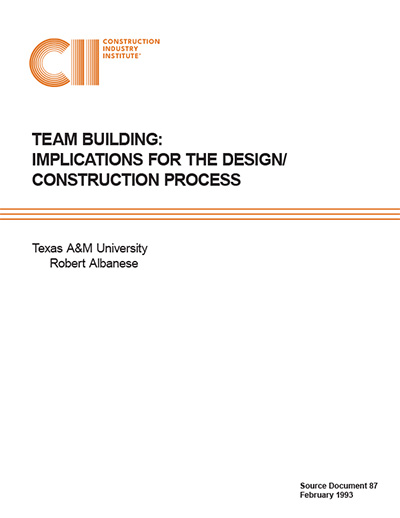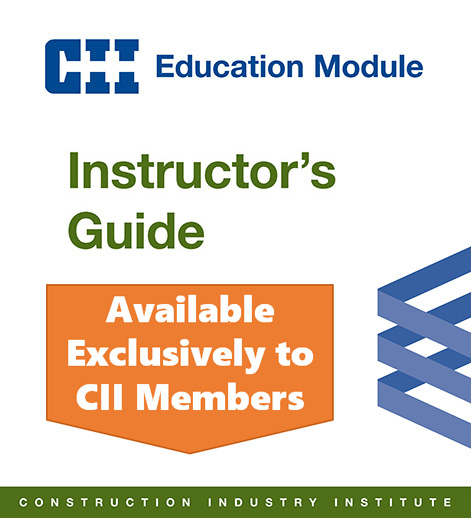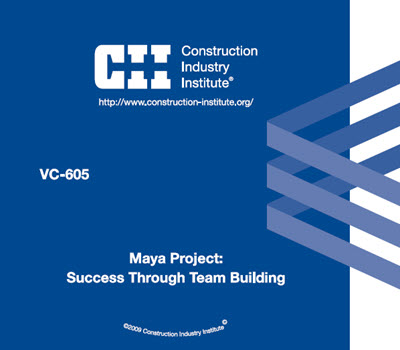
Team Building: Implications for the Design/Construction Process
Task Force Purpose. The CII Project Team Building Task Force was formed in April 1990. Its Purpose was to research the owner/designer/contractor/ project team approach as a means for minimizing adversarial relationships and for contributing to a more effective design/construction process. The task force focused on various management aspects of the team approach, not on the technology—the “how-to-do-it” of team building.
This Source Document. This Source Document tells the story of the task force’s efforts to achieve its research purpose. It is divided into two major parts. The first part, Chapter 2, documents efforts made to define the research problem and methodology. Part 2, Chapter 3, documents the task force’s major research process and findings.
Major Conclusion. The task force’s major conclusion is straightforward: A successful project team approach can bring to the design/construction process significant short-run and long-run benefits—benefits that can far outweigh costs typically incurred by the team approach. The team approach is a true “step change” in the way project management usually has been conceptualized and implemented.
Team Building and Partnering. Both “team building” and “partnering” are forms of collaboration that can involve an owner, designer, and contractor. A distinction between these two forms of collaboration is made in this Source Document. Partnering, the subject of CII Special Publication 17-1, generally involves a long-term commitment and typically is not project specific. Team building, as viewed by the task force, is a project-specific process that facilitates development of an effective project management team. Its use may be in conjunction with a partnering relationship, but not necessarily. It should be noted that, in practice, the terms team building and partnering often are used synonomously. For example, the United States Army Corps of Engineers uses the term partnering in a way identical to the way the term team building is used in this Source Document.
In the context of this research, team building always refers to inter-organizational teams—teams involving members of an owner, designer, and contractor organization. It does not refer to intra-organizational teams—teams used solely within a single business firm.
Preliminary Studies. To define its research problem, the task force held several discussion meetings and conducted three small surveys. The purpose of the surveys was to gather information from owners, designers, and contractors, and human resource personnel that the task force could use in defining its major research problem. Details of these studies are The task force reached the following surveys:
- The owners, designers, contractors, and human resource personnel who participated in these studies did not provide significantly different responses to the questions asked.
- Most of the individuals who participated in these studies have been involved in an inter-organizational team-building process involving an owner, designer, and contractor. Of these, almost all felt that the team-building process was beneficial in reducing adversarial relations.
- An adversarial relationship among a project’s owner, designer, and contractor is common and often adds significantly to project costs.
- The adversarial relationship among a project’s owner, designer, and contractor can be reduced if they invest the time and effort to build an effective project team. Best results are produced when all participants interact to improve processes.
- The adversarial relationship among a project’s owner, designer, and contractor cannot be attributed solely to the contractor, even though the contractor often gets the blame for poor project cost effectiveness.
- Working relations among a project’s owner, designer, and contractor that are characterized by trust, cooperation, and sharing of a common goal or set of goals are a major contributor to project cost effectiveness.
- There was strong agreement among the participants in the studies that poor project scope definition, excessive project changes, and poor management of the project change process are important potential causes of the adversarial relationship among a project’s owner, designer, and contractor. Other important potential causes are lack of agreement on project objectives, the project schedule, and the project budget.
- The participants in the studies indicated that several factors are likely to have a mild or insignificant impact on total project cost. These factors are: type of project contract, quality/workmanship requirements, extent of inspection, payments, material deliveries, personnel conflicts, risk allocation, and excessive administrative requirements.
- Human resource professionals in owner, designer, and contractor organizations are a largely untapped but potentially useful organizational resource in efforts to build inter-organizational project teams.
Literature review, surveys, and discussions of survey results provided the basis for developing the task force’s research questions, objectives, methodology, and process. These are discussed in this Source Document as are the characteristics of the sample used. Essentially, the task force identified a sample of 41 projects that had used a project team approach. Information on these projects was collected by personal interviews that utilized a structured interview format and by a questionnaire. This information was then analyzed for what it had to say about the following:
- The decision to use team building
- Obstacles to getting started using team building
- The team-building process
- Obstacles in implementing team building
- Characteristics of project teams
- Costs/benefits of team building
- Team relations questionnaire results
Decision to Use Team Building. Two major factors encouraged the decision by an owner, designer, and/or contractor to use team building: successful previous experience with inter-organizational team building, and the presence of a team-building “champion,” usually within the owner organization. Team building was most commonly seen as a pro-active way to manage a project in a win-win environment.
Obstacles to Getting Started Using Team Building. There were some obstacles encountered, and they are identified in the Source Document. However, no particular obstacle was encountered by the interviewees across more than a few projects. The task force had expected two major obstacles would be identified: lack of top management support and difficulty in changing the traditional approach to project management. Both obstacles were found to be nonexistent or overcome in the task force’s sample of projects.
The Team-Building Process. The team-building processes studied by the task force were overwhelmingly successful. Interviewees on 100% of the projects said they would use team building again. While not all expectations were met, not one interviewee felt the experience was not beneficial, personally or organizationally.
A consultant was used most times to facilitate the team-building process projects studied. External consultants were used on 25 of the projects, and internal consultants on 14. Thus, the task force’s research does not support the view that external consultants are required for the most effective team-building facilitation. However, the research also found a concern expressed that internal facilitators may be biased by their company culture and that they may lack credibility with individuals outside of their organization.
Only one interviewee did not suggest at least one change that could be made in the team-building process. The most frequently mentioned suggested changes were to involve more people in the team building and to start team building earlier in the project life.
Obstacles to Implementing Team Building. The interesting finding here is the absence of major implementation obstacles. While there were several cited by interviewees, none stood out across projects. This was true even on those projects where the parties involved had little or no previous experience with team building. The task force had expected interviewees to cite two potential obstacles: difficulty in developing trust among team members and inadequate availability of team-building training. Each of these potential obstacles was noted by only a few interviewees.
Characteristics of Project Teams. Every project studied was not a team-building “home run.” Even successful project teams have teamwork problems. Team building is no panacea. Nevertheless, team members on successful project teams: had shared goals, were interdependent, trusted each other, shared a commitment to work together, shared a sense of accountability or shared actual accountability, took pride in their team, openly communicated, received substantial intrinsic satisfaction from being a team member, received small (but meaningful) extrinsic rewards, and gave each other a lot of feedback.
Costs/Benefits of Team Building. The interviewees provided clear messages on the costs and benefits of team building. First, while costs and benefits can be quantified through accounting procedures, the costs and benefits cited by interviewees usually were not expressed in dollar terms. There was simply little interest in doing the kind of data gathering essential for a systematic accounting of costs and benefits. The payoff from such data gathering was viewed as problematic.
Second, there are costs associated with team building, and some of these costs are identified in the source Document. These costs are unlikely to be a deciding factor in the decision to use or not use team building. Relative to total project costs, the costs that could be associated with team building are minor.
Third, on all but three projects studied, the interviewees were effusive in commenting on the benefits of team building. The benefits were seen as far outweighing the Costs. Benefits cited by interviewees can be grouped into content or “tangible” benefits and process or “soft” benefits. Examples of both types are included in the Source Document. Both quantitative measures and qualitative information support the view that the use of team building brings major content and process benefits to project management.



